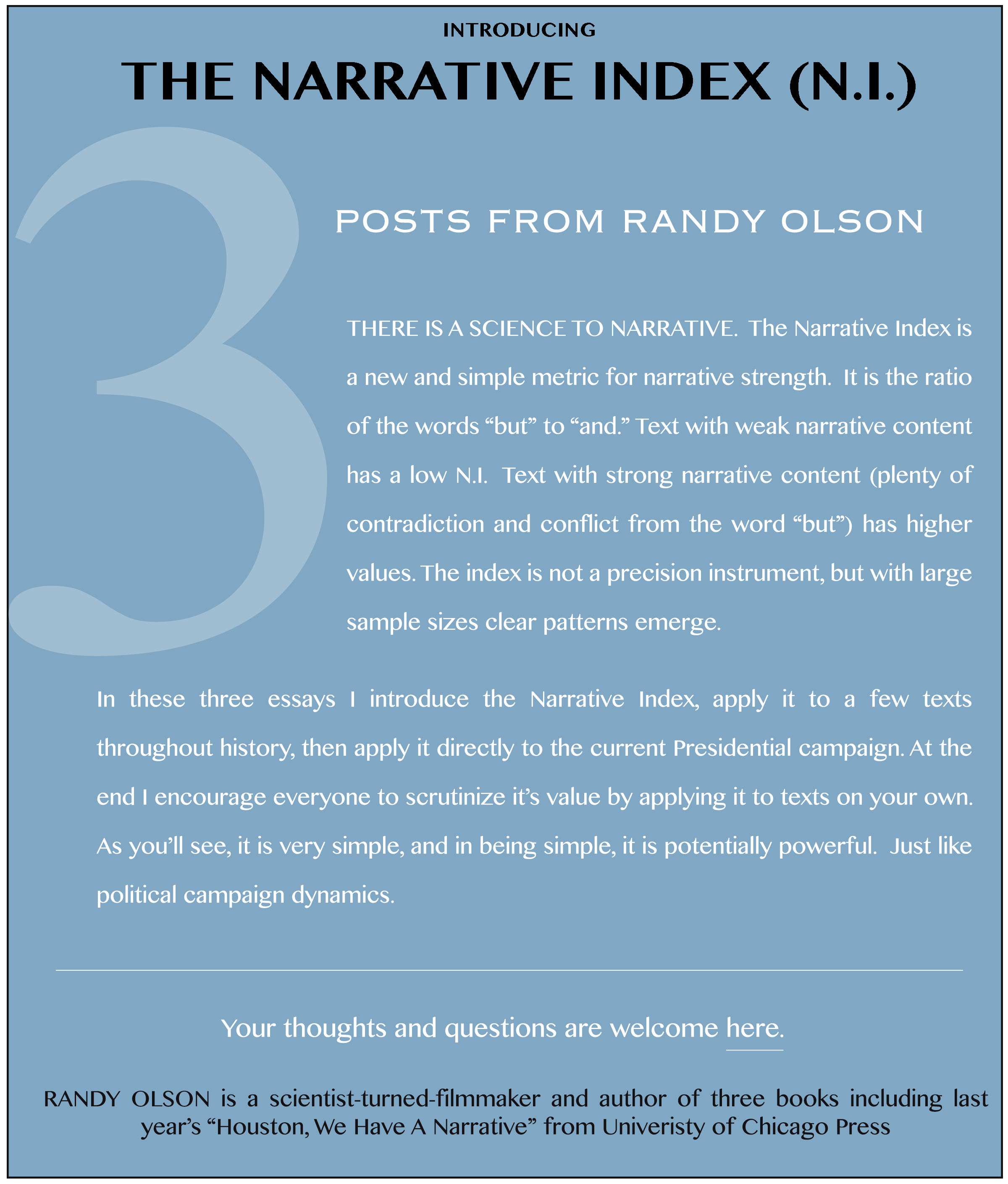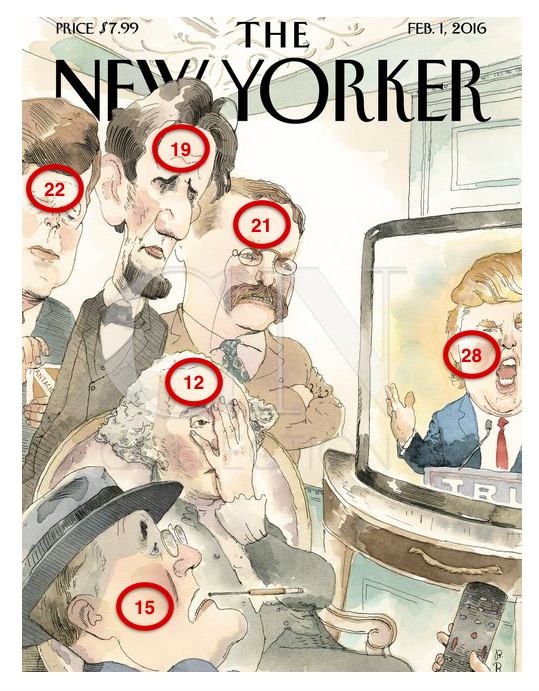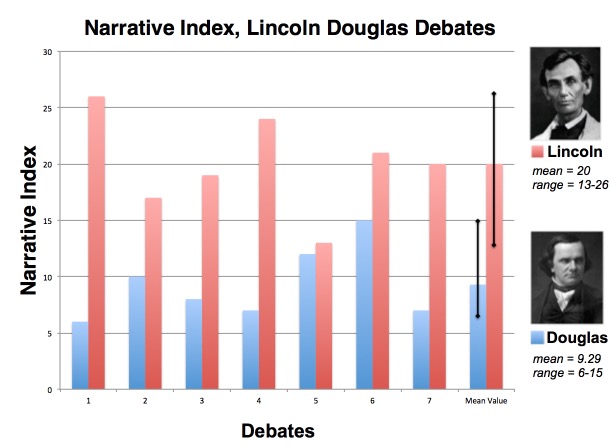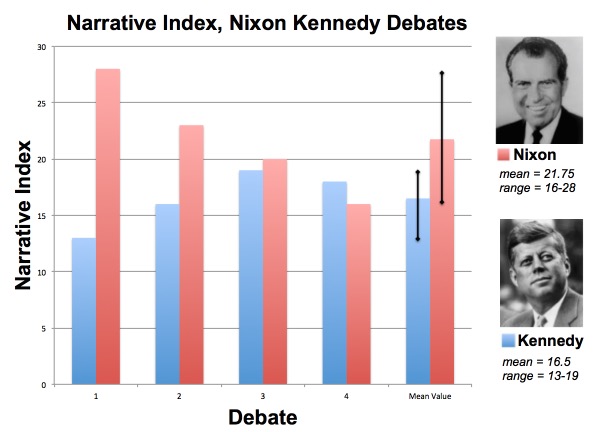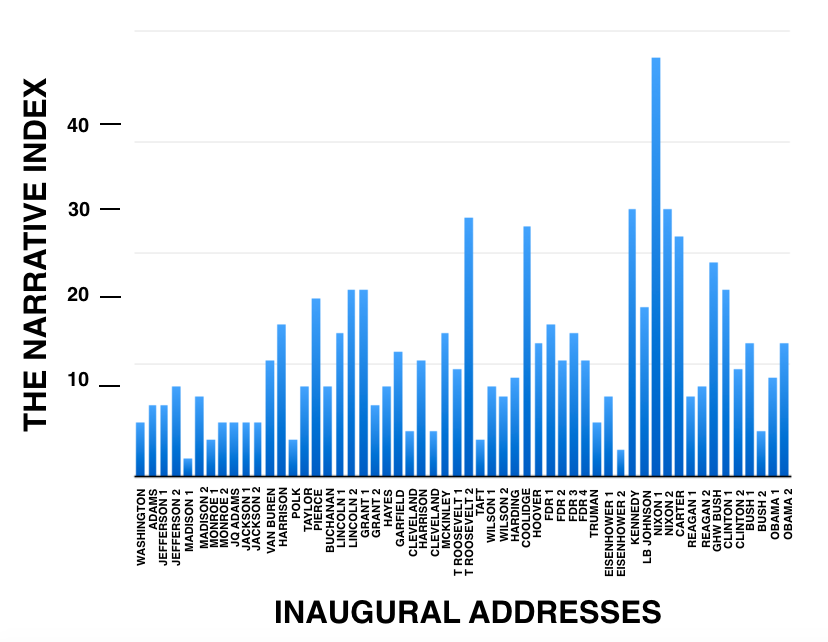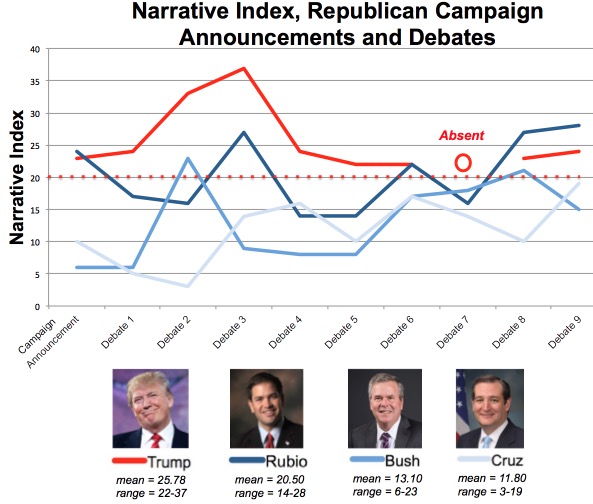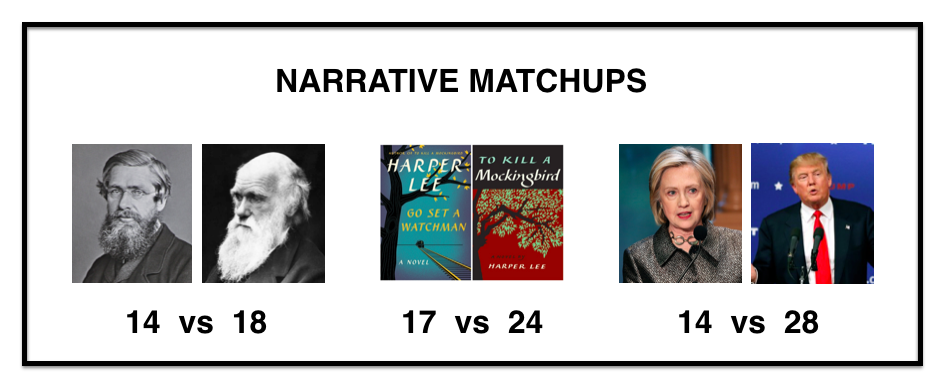NARRATIVE INDEX 1: The Metric
This is the first of three posts about what I believe to be a new and valuable communications tool. I have been trying since last September to interest the major political blogs in The Narrative Index (or N.I.) but they seem to be skeptical of both its newness and simplicity. Let’s see what you think. The data speak for themselves.
AN INDEX OF NARRATIVE STRENGTH
Some texts grab your attention and don’t let you go. Other texts put you to sleep. Wouldn’t it be nice if there were a single number that reflected this property?
Just over four years ago when I came across the extremely simple concept of “The Rule of Replacing” (as espoused by the co-creators of the animated series “South Park”) I found myself saying “surely it can’t be that simple.” Since then I’ve put that skepticism to the test though countless talks, a TEDMED presentation, a letter in Science, a webinar, and finally an entire book about it last fall titled, “Houston, We Have A Narrative.”
My main activity this year is fulfilling the vision of the book — propagating the ABT Framework by creating Story Circles Narrative Fitness Training which you can read about on our website. The next event will involve 40 biologists from USDA, USFWS and USGS next week in Ft. Collins, Colorado.
As a result of all this effort, I’m now certain that narrative structure, at it’s core, is indeed as simple as ABT. So what’s next?
Last summer I had a new revelation about the ABT template. It was the thought that if you were to use the Rule of Replacing, all else equal, when you finished with a given text you would have altered the ratio of the number of “buts” to “ands.” This ratio becomes a single number reflective of the strength of the narrative content of the material. Here’s how it works.
THE “BUT” WORD
“But” is the word of contradiction in the ABT. It is the heart and soul of narrative. There are lots of other words of contradiction (however, despite, yet), BUT … if you were to quantify it, you would easily see that BUT is the most common.
In fact there is a website that presents the 5,000 most common words in The Corpus of Contemporary English. Here’s how a few interesting words score on that list (how frequently they are used in the English language):
and – 3
but – 23
or – 32
while – 153
yet – 276
however – 285
despite – 772
instead – 997
“But” is the only connector word of contradiction in the top 100, aside from “or” which doesn’t have any narrative strength.
More importantly, all you have to do is look at the front page of a newspaper to see that most stories (if they are written well) begin with a few facts then a “but” (I’m looking at the front page of the NY Times for Feb. 13, 2016 and I see three of the four stories above the fold have this structure — two using “but,” one using “instead,” — and now I’m looking at Sunday Feb. 21 and see 3 of the 5 stories on the front page open with the ABT structure — again two “buts” and an “instead”).
“But” is central to having good narrative strength. At the other end of the spectrum (specifically “The Narrative Spectrum” as I labeled it in my book) is the template of, “And, And, And” text or AAA. This is text that is almost devoid of narrative content — just a string of comments tied together by the word of agreement, “and.”
The bottom line is that the more times you are saying “but” relative to “and” the more narrative strength there is to the content you are presenting. To quantify this ratio I have created this single calculation:
THE NARRATIVE INDEX = Buts/Ands X 100
I’ve had lengthy discussions with colleagues — especially my old buddy Bill Dennison at University of Maryland Center for Environmental Science, who will be posting his own essay tomorrow on applying the Narrative Index to the co-discoverers of the theory of evolution by means of natural selection, Charles Darwin versus Alfred Russell Wallace. Out of those discussions I’ve opted for simplicity by just keeping it as the ratio of buts to ands, multiplied by 100 to make it a whole number.
To calculate it for a given text, all you do is copy the material into a word processor, search for “and” and “but,” record their abundances, then divide.
Here, let’s do it for the story on Scalia on the front page of the Feb 15, 2016 NY Times.
But – 10
And – 27
Narrative Index (But/And) X 100 = 37
That’s actually a pretty high value, but to be expected for the front page of the NY Times — no room for ambling, unfocused AAA presentations there.
So that’s how simple it is to calculate. Try it for yourself on a body of text. In the next post I’ll set to work showing you the patterns that emerge for everyone from scientists to politicians.
NARRATIVE INDEX 2: The Baseline
I have proposed a Narrative Index for evaluating the “narrative strength” of any given text. It needs a substantial amount of text (at least a few thousand words) to have much reliability. But when you analyze large amounts of material throughout history, clear patterns emerge — especially for great communicators.
LINCOLN THE TORTOISE VS. DOUGLAS THE HARE
The famous Lincoln-Douglas debates provide the perfect starting point for seeing how much The Narrative Index reveals. In the summer of 1858 Abraham Lincoln — the Republican candidate for Senator from Illinois — squared off in seven debates with the incumbant Stephen Douglas.
All of the debates used the format of 60:90:30 — the opening candidate spoke for 60 minutes, the opponent got a 90 minute rebuttal, then the opener was given a half hour to finish. Just speeches, no questions from moderators. The debates drew huge audiences (tens of thousands) with the texts being widely printed in newspapers. There was some fudging of the transcripts by papers favorable to each candidate, but only minor variations. For my analysis I have used the version presented on the website of the National Park Service.
The result for each debate is a solid sample size of the candidates’ rhetoric — around 10,000 words for each debater’s individual performance. What you see in the figure above for their Narrative Index values is that they barely even overlapped. Douglas’ highest value (15) was only a little more than Lincoln’s lowest (13). Most of the time they weren’t even close.
In simple terms, Abe was telling ABT’s while Douglas was “Anding.” Lincoln had much greater narrative strength. When you read the accounts of witnesses you hear color commentary bringing these data to life. Observers told about how confident and arrogant Douglas was at the start, viewing Lincoln as much less experienced and thinking he would be easily out-witted. But by the fourth debate the audiences were rallying for Abe as Douglas began to sweat. You can see when it came to narrative strength, he was dwarfed by Abe for the first four debates. In the fifth debate he stepped things up a bit, but by then it was too late and he was starting to get ill. By the end he was collapsing in defeat.
THE AAA’er VS. THE ABT’er
For the first four debates Douglas was below 10 while Abe was spiking up to 25. What does this mean specifically?
Look at their opening lines of the first debate. Douglas begins with a string of statements — he’s pure “and, and, and” (AAA) in form:
Prior to 1854 this country was divided into two great political parties, known as the Whig and Democratic parties. Both were national and patriotic, advocating principles that were universal in their application. An old line Whig could proclaim his principles in Louisiana and Massachusetts alike. Whig principles had no boundary sectional line, they were not limited by the Ohio river, nor by the Potomac, nor by the line of the free and slave States …
Now look at Lincoln’s opening — it’s an ABT:
My fellow citizens: When a man hears himself somewhat misrepresented, it provokes him. At least, I find it so with myself; but when misrepresentation becomes very gross and palpable, it is more apt to amuse him. (THEREFORE) The first thing I see fit to notice, is the fact that Judge Douglas alleges, after running through the history of the old Democratic and the old Whig parties, that Judge Trumbull and myself made an arrangement in 1854 …
There you have the fundamental difference in style between the two speakers. Even more telling was one reporter who said, “Lincoln’s “words did not flow in a rushing, unbroken stream like Douglas.”
That says it all. The whole thing about the AAA is that it is the easy, default mode of communication — easy to spew out quickly (i.e. comes out as “a rushing, unbroken stream”) because it doesn’t involve the narrative parts of the brain — it’s just shooting out statements.
Activating the narrative regions slows things down. Lincoln was clearly the more thoughtful speaker, constructing his ideas with more narrative structure.
Though he lost to Douglas in the 1859 election, he of course beat him for President the next year and went down in history as a great speaker. His two inaugural speeches scored 16 and 21, respectively for the N.I. His “House Divided” speech was a 21, his Cooper Union speech was 20, and of course his most famous speech, the Gettysburg Address, while too short to justify analysis (it has just 6 “ands” with 2 “ buts” for an unusually high N.I. of 33) is just one big ABT of three paragraphs total.
Clearly Lincoln had deep narrative intuition. The Narrative Index gives us a means of quantifying this comparatively.
THE KENNEDY-NIXON DEBATES: RADIO VERSUS TELEVISION
Perhaps the second most famous set of debates in American History were the four held in 1960 between Presidential candidates John F. Kennedy and Richard Nixon. You can see Nixon out-scored Kennedy in terms of the Narrative Index for the first three debates, yet by the third one there was widespread agreement that Kennedy was winning. How could that have been? This is the exception that proves the rule.
For the first debate it was widely reported that polls of people listening on the radio had Nixon as the winner. There’s your narrative content at work. When all that people received was the words through their radio, the narrative structure won out.
But television viewers scored it differently. They scored the handsome, relaxed, young Kennedy — who came to be known as the first “telegenic President” — as much more effective than the nervous, sweaty Nixon with the five o’clock shadow. These were elements of communication left out of radio or the written text.
The Kennedy-Nixon debates (as wonderfully presented in David Halberstam’s, “The Powers That Be”) defined the beginning of “The Age of the Television President.” Things were never the same. The divide between radio and television scoring for the first debate shows the relative importance of substance (what they were saying) versus style (how they looked).
INAUGURATION AND STATE OF THE UNION SPEECHES
Broader patterns emerge when you look at all the inauguration speeches of the Presidents. There’s substantial variation and at least a few scores that are minor head scratchers. For example, Calvin Coolidge was known as “Silent Cal” — you wouldn’t really expect him to have one of the highest values of all time (he scored a 29). But on the other hand, despite his penchant for few words, he was actually known as a skilled speaker. More importantly, of the six other of his speeches I’ve analyzed, the lowest was still a 14, so he wasn’t devoid of narrative intuition.
Equally somewhat disappointing is Obama. You’d hope he would score highly, but his two inaugurals are 11 and 15 while his State of the Union speeches range from 12 to 19. It seems to be the case he doesn’t draw heavily on narrative structure. Of the 10 speeches I’ve analyzed, they range only from 9 to 18. I wish I could say his Reverend Wright speech was a barn burner — it’s my favorite of his speeches — but it’s only 15. I’m afraid the numbers are very consistent for him — never into the 20’s. Which means you don’t have to have a huge N.I. to be a great speaker, but it’s still a significant characteristic of most effective communicators, and nobody has labeled Obama “The Great Communicator” as they did with Reagan.
It’s clear a lot of early Presidents hardly ever said “but.” But … there are interesting spikes with Lincoln, Teddy Roosevelt, and eventually the ultimate monster of ambition, Nixon, who set the bar highest.
NARRATIVE ANEMIA
What’s more interesting and even fun are the dishrags. Some folks just don’t seem to bring any narrative content to what they have to say. Not surprisingly, they are all known as kind of wishy washy.
I’m talking about not just those early, polite Presidents, and not just Eisenhower who didn’t score above 10 for either of his inaugurals nor any of his first five State of the Union speeches. The guy I’m talking about is George W. Bush.
Not only did Bush score a mere 5 for his second inaugural, it turns out none of his seven State of the Union speeches — not even after 9/11 — managed to score above 10. They were: 4, 2, 3 4, 5, 4, 4. Is that a surprise? Would anyone ever have called him a great speaker? He was the ultimate “And, And, Ander.” It’s kind of the whole spin Will Ferrell put on him — the guy speaking vacuous statements, reaching for something clever, ultimately only able to say, “strategery” — unable to turn a phrase.
In contrast, Nixon’s State of the Union speeches for 1970 to 1974 were 27, 16, 23, 18. He always had something urgent and important to say. But did Nixon really have that good of a feel for narrative structure? Yes. Just look at how he opens his record-setting first inaugural (scored a 46).
He begins with an eloquent ABT:
“I ask you to share with me today the majesty of this moment. In the orderly transfer of power, we celebrate the unity that keeps us free. Each moment in history is a fleeting time, precious and unique. But some stand out as moments of beginning, in which courses are set that shape decades or centuries. This can be such a moment.” (ominous opening words from the eventual captain of the Titanic)
MODERATORS: THE ABT DRIVERS
As you can imagine, countless fascinating observations begin to emerge from this single index. In the third and final post I will get deeply into the current Presidential Debates. But before I do, let’s take a look at the basic dynamic of “ABT Driving.” What I mean by this is using the ABT elements to basically “advance the narrative.”
This is the fundamental need for narrative, in order to keep it interesting — it must be advanced. You must constantly be adding sources of contradiction, then driving for consequences. We can see this at work clearly with the moderators of today’s television debates.
Television producers live in dread fear of boring their audience. It’s the job of the moderators to prevent this by interrupting the debaters, and more importantly, interjecting conflict by squaring them off against each other. You hear the moderators saying over and over again, “Candidate A, last week you said X, BUT your opponent said Y, how do you reconcile this?” If they are doing their job properly they are constantly driving the narrative dynamics.
This ends up showing clearly in the collective N.I. value for the moderators of each debate. Look at the third Democrat Debate — they reached 56, which is unheard of for a speaker. And you can even add to that a fair amount of non-narrative logistics explanations and pleasantries. Clearly their job is to drive the conflict.
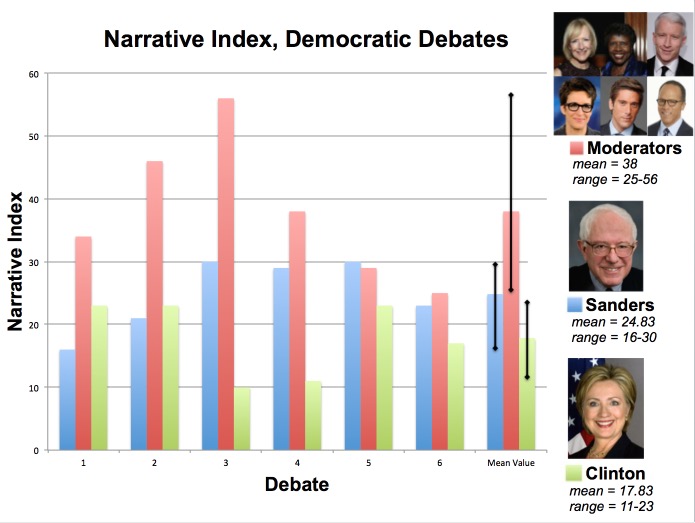
THE ABT DRIVERS: Clinton and Sanders are kind of a big whatever in narrative terms, but far more interesting is the role of the Moderators. It’s their job to “advance the narrative.” This is reflected in the N.I.
SO WHAT IF THERE WAS A PRESIDENT WHO NEVER, EVER SLIPPED BELOW A NARRATIVE INDEX OF 20?
Guess where this all leads. I’ve analyzed hundreds of speeches since last summer. I’ve found only one politician who has NEVER given a speech or debate performance below 20. Guess who …
NARRATIVE INDEX 2: The Candidates
TRUMP: THE HIGHEST NARRATIVE BATTING AVERAGE … EVER
I’ve been following Trump’s performances for nearly a year using The Narrative Index which I laid out in the previous two blogs. At first I thought his high values were curious. Now I find them alarming.
There has never been a politician like Trump. Lots of political pundits are now trying to say this, but the problem is they are inarticulate, non-analytical, and just plain simplistic (NOT the same as simple) in their assessments. They analyze his speech and use of language, but fail to come up with anything more sophisticated than the idea that he talks on the level of a 3rd grader (Politico), a 4th grader (Newsweek), a 5th grader (NY Daily News), or uses lots of “us” and “they” pronouns (NY Times). Gee, way to bring out the heavy guns of analysis.
NONE of the shallow, silly analyses are worth reading nor have sustained any useful lines of thought.
But narrative is different. It is the core of human culture. It goes back at least 4,000 years. It is the essence of how we communicate. So let’s begin with one important point.
REAGAN WAS A STORYTELLER, TRUMP IS A MASTER OF NARRATIVE
This is the simplest way to convey the distinction between these two terms. Storytelling and narrative are not the same.
Reagan, who came to be adored as “The Great Communicator,” was beloved for his storytelling skills. But in contrast, nobody has ever loved a story told by Trump. He’s not a good storyteller. His stories are choppy, not much fun, and waste little time in getting to the point (which is what he lives for). Yet Trump is a master of narrative.
How could this be? Aren’t storytelling and narrative the same thing? No.
In my book I offered up the simple definition of narrative as, “The series of events that occur in the search for a solution to a problem.” That’s it. That’s what the narrative dynamic is about.
Narrative is the driving force at the core of a story. All good stories are built around the search for the solution to a problem. Whether it’s figuring out the murderer, finding your way home, or defeating a threat, it is all about problem/solution. But a story involves many more elements wrapped around the narrative core.
Reagan was a storyteller. He knew how to present stories with all their warmth, humor and emotion. His stories were always about problems. Trump doesn’t give much of a crap about the warmth, humor or emotion. He’s mostly just about problem-solution, over and over again, all day long.
You hear it in Trump’s speeches and debate performances — very tight narrative loops of problem-solution. “Jeb’s a great guy, but he’s weak (PROBLEM), therefore he needs to go home (SOLUTION).” “We love our Mexican friends, but too many are illegal (PROBLEM), therefore we need to build a wall (SOLUTION).” “Muslims are mostly okay, but some are terrorists (PROBLEM), therefore we need to stop their entry (SOLUTION).” “Our country used to be great, but now it’s slipped in the world (PROBLEM), therefore we need to Make America Great Again (SOLUTION).”
You hear narrative structure in almost everything he says, and it manifests itself in part through the use of the word “but.” It’s not the only important narrative word, but as I explained in the earlier posts, it’s the most common. Trump uses it more than any other politician. Ever.
THE REPUBLICAN DEBATES
There have been nine Republican debates so far. Trump has scored a Narrative Index above 20 for every performance. No one else has done this. Same thing for all his speeches. Same thing for all his press conferences. I’ve analyzed a total of 23 performances. Not just always above 20, he’s scored as high as 58 in his June 28 interview with Jake Tapper. The man breathes narrative structure.
TRUMP OWNS MSNBC
Of course he doesn’t own the network, but I’ve watched in disbelief since last summer as MSNBC has literally given over their network to him. Has anyone spoken out about this? Trump brags of all the free media exposure he scores. I thought MSNBC is left leaning. And yet, since last summer, night after night they have literally pre-empted their programming to cover just about every speech or press conference Trump has given.
They haven’t done this for ANY other candidate. Not even close. Not Hillary, not Bernie — not a one of them. Why?
The simple, non-quantitative answer is that “Trump is entertainment.” What does this mean? That he is funny? He’s not really that funny — not like a stand up comic, or any funnier than several other candidates. Is it that he’s crude and outlandish? There have been plenty of crude and outlandish politicians in the past. None have ever earned free air time by the hour.
The simple answer is that Trump delivers “concision.” He is physically constructed for the medium of television. He speaks in closed loops that have narrative structure. Yes, he repeats the same stuff, but so what. It’s about the smaller scale dynamic of each narrative loop. He starts a loop (addressing a problem), gets quickly to the “but” then quickly to the “therefore.” This is what I’ve been talking about with the Narrative Index. He has deep narrative intuition. And this is what television doesn’t just seek — it demands.
TELEVISION DEMANDS NARRATIVE, TRUMP DELIVERS
I don’t have the time and resources for massive data analysis. Hopefully someone else does. It would be nice to have a larger sample size than this. But look at the pattern for the N.I. for three PBS documentary shows plus “Cosmos.” I analyzed 4 of each and all 13 episodes of “Cosmos.” All of them average over 20 for their N.I. More data are needed to say it with complete confidence, but I’d be willing to bet there is a functional “narrative threshold” to television programming which is probably about 20. TV just has no tolerance for “and, and, and” drivel. Nor does Trump.
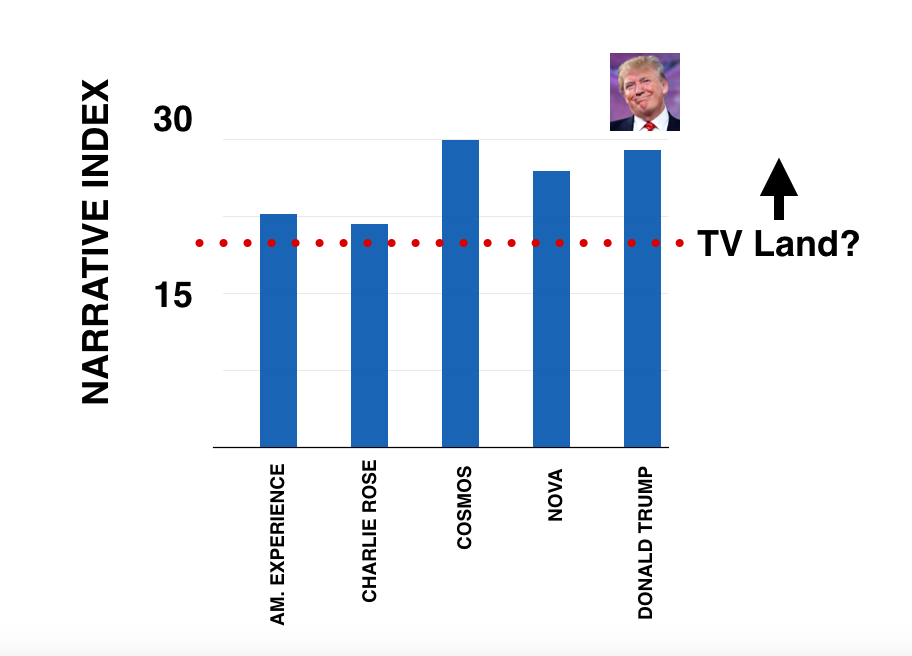
PRE-ADAPTED TO THE TV LANDSCAPE. Trump’s average Narrative Index of 28 matches what television demands. He is truly the candidate for today’s media-driven society. No other candidate is close.
TRUMP (THE DEALMAKER) KNOWS NARRATIVE
Trump embodies every principle of my book. He breathes narrative. Why? Because he’s a dealmaker. We all know this. It’s what his book is about. He wants to get to the “but” (what’s the problem that’s holding us up?) then immediately get to the “therefore.” He wants to advance the narrative, yet he also wants to “stay on narrative.”
What do we mean by staying on narrative? It means stating your narrative theme at the start of your journey (“To Make America Great Again”). Repeating it endlessly throughout the journey. Then eventually coming full circle by achieving it, which is his dream. He is the only one with this clearly defined narrative dynamic.
This is what I mean between simple versus a simpleton. If you think Trump is a simpleton with how he is running his campaign it is you who is the simpleton. This man knows the power of simplicity, and there is an age old adage that “simplicity is the ultimate sophistication.”
YOU SHOULD PUT THE NARRATIVE INDEX TO WORK
As I explained in the first of these three blogposts, the Narrative Index is very simple to calculate. Just copy, paste, count and divide.
You should put it to work with lots of stuff. Think of any text in the world. How much narrative strength does it have? You definitely need over 1,000 words, and I’d still be cautious until you’re getting closer to 10,000 words. But when you’re past 50,000 words the patterns appear pretty robust — as was the case for the Lincoln-Douglas debates.
One immediate application is my friend Bill Dennison who has applied it to the works of the co-discoverers of The Theory of Evolution By Means of Natural Selection, Charles Darwin and Alfred Russell Wallace. He just posted his very nice essay using the N.I. which provides at least one explanation of why one man became famous for eternity while the other largely vanished.
You can also put it to work with literary texts. Remember last year when literary experts were debating whether the new novel from Harper Lee, “Go Set A Watchman,” might simply be an early draft of her masterpiece, “To Kill A Mockingbird”? If you go with the assumption that the revision process for a story involves in part a variation of The Rule of Replacing (replacing “ands” with “buts”) then you would predict Watchman would be more of an AAA work while Mockingbird is more ABT.
The Narrative Index matches this prediction.Watchman scores an N.I. of 17 while Mockingbird scores a 24. It’s not the definitive proof, but is at least quantitative and in the case of these novels the sample size of total words is pretty large.
THE ULTIMATE CHALLENGE: HILLARY VERSUS TRUMP
From the start of the current Presidential campaign, Hillary has lacked the basic narrative elements that Trump has a mastery of. She never developed a simple, singular slogan. Even Bernie managed it with his “eat the rich” theme. When quizzed on Bernie’s approach to Wall Street she takes the AAA approach of “it’s not that simple.” She doesn’t drill into problem-solution dynamics the way Trump does, and now, most distressing, the numbers are stark for The Narrative Index.
Trump is never below 20 in the more than 20 performances of his I have analyzed. She ends up with an average of 14 (for 21 performances) with 6 of the scores being below 10, and only 5 over 20. In simple terms, she delivers half the narrative heft of Trump.
So what does this mean? It’s pretty simple. Do the math. She needs to get more focused, even at the finest scales of how she communicates. It’s a short attention span world today. Trump is pre-adapted to it. Hillary is communicating like the 90’s.
But here’s one glimmer of hope. The highest score I’ve ever found for her was a 27, which is right at Trump’s level. Guess where it was from. Her Wellesley College student commencement speech of 1969.

